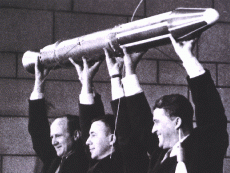 “I believe that this nation should commit itself to achieving the goal, before this decade is out, of landing a man on the Moon and returning him safely to the Earth. No single space project in this period will be more impressive to mankind, or more important for the long-range exploration of space; and none will be so difficult or expensive to accomplish.”
“I believe that this nation should commit itself to achieving the goal, before this decade is out, of landing a man on the Moon and returning him safely to the Earth. No single space project in this period will be more impressive to mankind, or more important for the long-range exploration of space; and none will be so difficult or expensive to accomplish.”
This sentence of John F. Kennedy, perfectly sums up the situation and composition of the world in the Cold War era. On the one hand USA and on the other, the USSR. The capitalist bloc and the communist bloc. Two ideologies, one goal: world domination.
Both were eager to global consideration, as the top world power, as the clearly dominant in the world, as the kings of kings. Both states, in that way for the supremacy, in that way to show the world who was the best, they engaged in a race to reach the moon. This battle lasted from 1957 – 1975 and it involved a huge financial effort, but also a great step forward for science.
 On the 28/02/2011 the russian Konstantín Bogdánov published an article entitled “The space race between USA and USSR was intense and ended in a draw.” This article is divided into different sections as “First intercontinental ballistic missile”, “USA space program” and “Who will be the first to walk on the moon?”, and offers a wide information about the race to space, being a very interesting source about this subject. As it is said in the title, the author, after various researches, reaches the conclusion that both drawed in this intense space race.
On the 28/02/2011 the russian Konstantín Bogdánov published an article entitled “The space race between USA and USSR was intense and ended in a draw.” This article is divided into different sections as “First intercontinental ballistic missile”, “USA space program” and “Who will be the first to walk on the moon?”, and offers a wide information about the race to space, being a very interesting source about this subject. As it is said in the title, the author, after various researches, reaches the conclusion that both drawed in this intense space race.
To finish collating the required information, the newspaper El Mundo contains an interesting article, in which, divided into different chapters, as “SPUTNIK 1“, “LAIKA”, “YURI GAGARIN”, ”ALEXEY LEONOV” and other, is shown how thrilling the space race was. The report also includes many features about this historic event, such as the trip of Neil Amstrong and the 12 “moonwalkers”.
To sum up, this wikipedia article, written in basque, is intended to explain the space race that pitted two powers, from both points of view, that is, from the Russian point of view, as in the article Bogdánov, and later explaining the point of view offered by NASA.
References:
http://www.elmundo.es/especiales/2009/07/ciencia/llegada_hombre_luna_1969/12_magnificos/index.html
http://sp.rian.ru/opinion_analysis/20110228/148443802.html
Filed under: Uncategorized
![]()